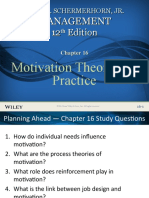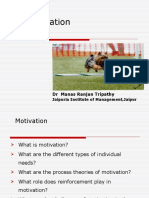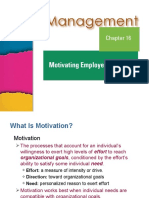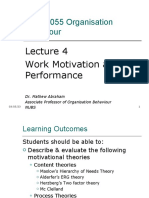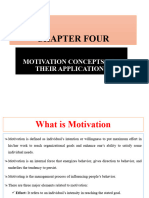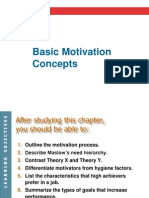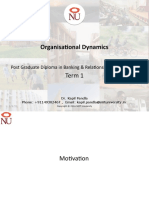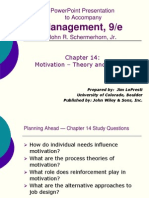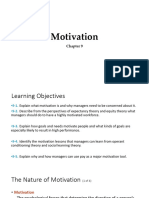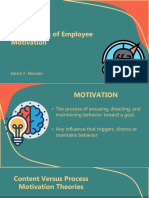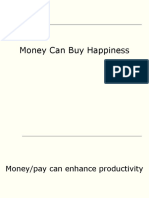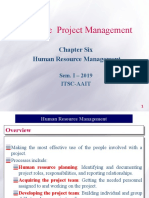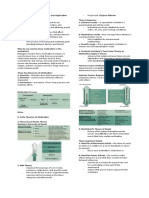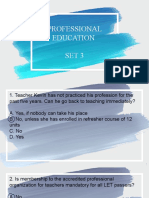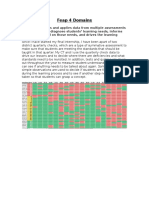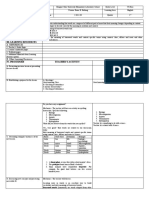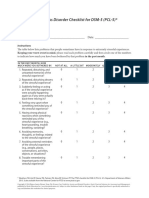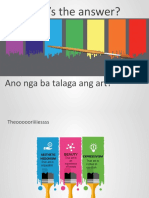Place Slide Title Text Here
JOHN R. SCHERMERHORN, JR.
MANAGEMENT
12 Edition
th
Chapter 16
Motivation Theory
and Practice
©2013 John Wiley & Sons, Inc. All rights reserved. 16-1
�Planning Ahead
Place Slide Title — Chapter
Text Here 16 Study Questions
1. How do individual needs influence
motivation?
2. What are the process theories of
motivation?
3. What role does reinforcement play in
motivation?
4. What is the link between job design and
motivation?
©2013 John Wiley & Sons, Inc. All rights reserved. 16-2
� Chapter
Place Slide Title 16 Learning
Text Here Dashboard
1. Individual Needs and Motivation
1. Hierarchy of needs theory
2. ERG theory
3. Two-factor theory
4. Acquired needs theory
2. Process Theories of Motivation
1. Equity theory
2. Expectancy theory
3. Goal-setting theory
4. Self-efficacy theory
©2013 John Wiley & Sons, Inc. All rights reserved. 16-3
� Chapter
Place Slide Title 16 Learning
Text Here Dashboard
3. Reinforcement Theory
1. Reinforcement strategies
2. Positive reinforcement
3. Punishment
4. Motivation and Job Design
1. Job simplification
2. Job enrichment
3. Alternative work schedules
©2013 John Wiley & Sons, Inc. All rights reserved. 16-4
�Takeaway
Place Slide1: Individual
Title Needs and Motivation
Text Here
Motivation—the forces within the individual
that account for the level, direction, and
persistence of effort expended at work
©2013 John Wiley & Sons, Inc. All rights reserved. 16-5
�Takeaway
Place Slide1: Individual
Title Needs and Motivation
Text Here
Needs
– Unfulfilled physiological and psychological desires
of an individual
– Explain workplace behavior and attitudes
– Create tensions that influence attitudes and
behavior
– Good managers and leaders facilitate employee
need satisfaction
©2013 John Wiley & Sons, Inc. All rights reserved. 16-6
�Takeaway
Place Slide1: Individual
Title Needs and Motivation
Text Here
Hierarchy of needs theory
– Developed by Abraham Maslow
– Lower-order and higher-order needs affect workplace
behavior and attitudes
– Lower-order needs:
• Physiological, safety, and social needs
• Desires for physical and social well being
– Higher-order needs:
• Esteem and self-actualization needs
• Desire for psychological growth and development
©2013 John Wiley & Sons, Inc. All rights reserved. 16-7
�Place Slide Title Text Here
©2013 John Wiley & Sons, Inc. All rights reserved. 16-8
�Place Slide Title Text Here
Figure 16.1 Opportunities for satisfaction in Maslow’s
hierarchy of human needs
©2013 John Wiley & Sons, Inc. All rights reserved. 16-9
�Takeaway
Place Slide1: Individual
Title Needs and Motivation
Text Here
Hierarchy of needs theory
– Deficit principle
• A satisfied need is not a motivator of
behavior
– Progression principle
• A need at one level does not become
activated until the next lower-level need is
satisfied
©2013 John Wiley & Sons, Inc. All rights reserved. 16-10
�Takeaway
Place Slide1: Individual
Title Needs and Motivation
Text Here
ERG theory
– Developed by Clayton Alderfer
– Three need levels
Existence Relatedness
Growth needs
needs needs
• desires for • desires for • desires for
physiological satisfying continued
and material interpersonal psychological
well-being relationships growth and
development
©2013 John Wiley & Sons, Inc. All rights reserved. 16-11
�Takeaway
Place Slide1: Individual
Title Needs and Motivation
Text Here
ERG theory
– Any/all needs can influence behavior at
one time
– Frustration-regression principle
• An already satisfied lower-level need becomes
reactivated when a higher-level need is
frustrated
©2013 John Wiley & Sons, Inc. All rights reserved. 16-12
�Takeaway
Place Slide1: Individual
Title Needs and Motivation
Text Here
Two-factor theory
– Developed by Frederick Herzberg
– Hygiene factors:
• Elements of the job context
• Sources of job dissatisfaction
– Satisfier factors:
• Elements of the job content
• Sources of job satisfaction and motivation
©2013 John Wiley & Sons, Inc. All rights reserved. 16-13
�Place Slide Title Text Here
Figure 16.2 Elements in Herzberg’s two-factor theory
©2013 John Wiley & Sons, Inc. All rights reserved. 16-14
�Takeaway
Place Slide1: Individual
Title Needs and Motivation
Text Here
Acquired needs theory
– Developed by David McClelland
– People acquire needs through their life
experiences Need for
– Needs that are acquired: Achievement
(nAch)
Need for Need for
Affiliation Power
(nAff) (nPower)
©2013 John Wiley & Sons, Inc. All rights reserved. 16-15
�Takeaway
Place Slide1: Individual
Title Needs and Motivation
Text Here
Acquired needs theory
– Need for Achievement (nAch)
• Desire to do something better or more efficiently, to
solve problems, or to master complex tasks
– People high in (nAch) prefer work that:
• Involves individual responsibility for results
• Involves achievable but challenging goals
• Provides feedback on performance
©2013 John Wiley & Sons, Inc. All rights reserved. 16-16
�Takeaway
Place Slide1: Individual
Title Needs and Motivation
Text Here
Acquired needs theory
– Need for Power (nPower)
• Desire to control other persons, to influence their
behavior, or to be responsible for other people
• Personal power versus social power
– People high in (nPower) prefer work that:
• Involves control over other persons
• Has an impact on people and events
• Brings public recognition and attention
©2013 John Wiley & Sons, Inc. All rights reserved. 16-17
�Takeaway
Place Slide1: Individual
Title Needs and Motivation
Text Here
Acquired needs theory
– Need for Affiliation (nAff)
• Desire to establish and maintain friendly and warm
relations with other persons
– People high in (nAff) prefer work that:
• Involves interpersonal relationships
• Provides for companionship
• Brings social approval
©2013 John Wiley & Sons, Inc. All rights reserved. 16-18
� Takeaway
Place 2: Process
Slide Title Theories of Motivation
Text Here
• Process theories of motivation …
– How people make choices to work hard or not
– Choices are based on:
• Individual preferences
• Available rewards
• Possible work outcomes
• Types of process theories:
– Equity theory
– Expectancy theory
– Goal-setting theory
©2013 John Wiley & Sons, Inc. All rights reserved. 16-19
� Takeaway
Place 2: Process
Slide Title Theories of Motivation
Text Here
Equity theory
– Developed by J. Stacy Adams
– When people believe that they have been treated
unfairly in comparison to others, they try to
eliminate the discomfort and restore a perceived
sense of equity to the situation
• Perceived inequity
• Perceived equity
©2013 John Wiley & Sons, Inc. All rights reserved. 16-20
�Place Slide Title Text Here
Figure 16.3 Equity theory and the role of social
comparison
©2013 John Wiley & Sons, Inc. All rights reserved. 16-21
� Takeaway
Place 2: Process
Slide Title Theories of Motivation
Text Here
Equity and social comparison
– People compare their ratio of outcomes-to-
inputs to the outcomes-to-inputs ratio of
another (a referent)
©2013 John Wiley & Sons, Inc. All rights reserved. 16-22
� Takeaway
Place 2: Process
Slide Title Theories of Motivation
Text Here
– Over-reward inequity (positive inequity) occurs
when an individual perceives that rewards received
are more than what is fair for work inputs
– Under-reward inequity (negative inequity) occurs
when an individual perceives that rewards received
are less than what is fair for work inputs
©2013 John Wiley & Sons, Inc. All rights reserved. 16-23
� Takeaway
Place 2: Process
Slide Title Theories of Motivation
Text Here
Equity theory
– People respond to perceived negative inequity by
changing …
• Work inputs
• Rewards received
• Referent’s inputs or outcomes
• Comparison points
• Situation
©2013 John Wiley & Sons, Inc. All rights reserved. 16-24
� Takeaway
Place 2: Process
Slide Title Theories of Motivation
Text Here
Managerial implications of equity theory—
– Underpaid people experience anger
– Overpaid people experience guilt
– Perceptions of rewards determine motivational outcomes
– Negative consequences of equity comparisons should be
minimized, if not eliminated
– Do not underestimate the impact of pay as a source of
equity controversies in the workplace
• Gender equity
• Comparable worth
©2013 John Wiley & Sons, Inc. All rights reserved. 16-25
� Takeaway
Place 2: Process
Slide Title Theories of Motivation
Text Here
Expectancy theory
– Developed by Victor Vroom
– Key expectancy theory variables:
• Expectancy — belief that working hard will result in
desired level of performance
• Instrumentality — belief that successful performance
will be followed by rewards
• Valence — value a person assigns to rewards and
other work related outcomes
©2013 John Wiley & Sons, Inc. All rights reserved. 16-26
�Place Slide Title Text Here
©2013 John Wiley & Sons, Inc. All rights reserved. 16-27
�Place Slide Title Text Here
Figure 16.4 Elements in the expectancy theory of
motivation
©2013 John Wiley & Sons, Inc. All rights reserved. 16-28
� Takeaway
Place 2: Process
Slide Title Theories of Motivation
Text Here
Expectancy theory
– Motivation (M), expectancy (E), instrumentality (I),
and valence (V) are related to one another in a
multiplicative fashion:
Motivation = Expectancy x Instrumentality x Valence
If either E, I, or V is low, motivation will be low
©2013 John Wiley & Sons, Inc. All rights reserved. 16-29
� Takeaway
Place 2: Process
Slide Title Theories of Motivation
Text Here
Managerial implications of expectancy theory
– To maximize expectancy, managers should:
• Select workers with ability
• Train workers to use ability
• Support work efforts
• Clarify performance goals
©2013 John Wiley & Sons, Inc. All rights reserved. 16-30
� Takeaway
Place 2: Process
Slide Title Theories of Motivation
Text Here
Managerial implications of expectancy theory
– To maximize instrumentality, managers should:
• Clarify psychological contracts
• Communicate performance-outcome possibilities
• Identify rewards that are contingent on performance
©2013 John Wiley & Sons, Inc. All rights reserved. 16-31
� Takeaway
Place 2: Process
Slide Title Theories of Motivation
Text Here
Managerial implications of expectancy theory
– To maximize valence in a positive direction,
managers should:
• Use content theories
• Increase communication
• Link needs/desires with rewards
©2013 John Wiley & Sons, Inc. All rights reserved. 16-32
� Takeaway
Place 2: Process
Slide Title Theories of Motivation
Text Here
Goal-setting theory
– Developed by Edwin Locke
– Properly set and well-managed task goals can be
highly motivating
– Motivational effects of task goals:
• Provide direction to people in their work
• Clarify performance expectations
• Establish a frame of reference for feedback
• Provide a foundation for behavioral self-management
©2013 John Wiley & Sons, Inc. All rights reserved. 16-33
� Takeaway
Place 2: Process
Slide Title Theories of Motivation
Text Here
How to Make Goal Setting Work for You:
• Set specific goals
• Set challenging goals
• Build goal acceptance and commitment
• Clarify goal priorities
• Provide feedback on goal accomplishment
• Reward goal accomplishment
©2013 John Wiley & Sons, Inc. All rights reserved. 16-34
� Takeaway
Place 2: Process
Slide Title Theories of Motivation
Text Here
Goal-setting theory
– Participation in goal setting
• unlocks the motivational potential of goal setting
• management by objectives (MBO) promotes
participation
• when participation is not possible, workers will
respond positively if supervisory trust and support
exist
©2013 John Wiley & Sons, Inc. All rights reserved. 16-35
� Takeaway
Place 2: Process
Slide Title Theories of Motivation
Text Here
Self-Efficacy Theory
– a person’s belief that he or she is capable of
performing a task
– Capability directly affects motivation
• higher self-efficacy will have higher expectancy
• self-efficacy is linked to performance goal setting
©2013 John Wiley & Sons, Inc. All rights reserved. 16-36
� Takeaway
Place 2: Process
Slide Title Theories of Motivation
Text Here
Self-Efficacy Theory
– Enactive mastery
• person gains confidence through positive experience
– Vicarious modeling
• learning by observing others
– Verbal persuasion
• encouragement from others that one can perform a task
– Emotional arousal
• high stimulation or energy to perform well in a situation
©2013 John Wiley & Sons, Inc. All rights reserved. 16-37
�Place Takeaway
Slide Title 3: Reinforcement
Text Here Theory
Fundamentals of reinforcement theory
– Focuses on the impact of external environmental
consequences on behavior
– Law of effect — behavior followed by pleasant
consequences is likely to be repeated: behavior
followed by unpleasant consequences is not
©2013 John Wiley & Sons, Inc. All rights reserved. 16-38
�Place Takeaway
Slide Title 3: Reinforcement
Text Here Theory
Operant conditioning:
– Developed by B.F. Skinner
– Applies law of effect to control behavior by
manipulating its consequences
– https://www.youtube.com/watch?v=ne6o-
uPJarA
©2013 John Wiley & Sons, Inc. All rights reserved. 16-39
�Place Takeaway
Slide Title 3: Reinforcement
Text Here Theory
Operant conditioning strategies:
– Positive reinforcement
• Increases the frequency of a behavior through the
contingent presentation of a pleasant consequence
– Negative reinforcement
• Increases the frequency of a behavior through the
contingent removal of an unpleasant consequence
©2013 John Wiley & Sons, Inc. All rights reserved. 16-40
�Place Takeaway
Slide Title 3: Reinforcement
Text Here Theory
Operant conditioning strategies:
– Punishment
• Decreases the frequency of a behavior through the
contingent presentation of an unpleasant
consequence
– Extinction
• Decreases the frequency of a behavior through the
contingent removal of an pleasant consequence
©2013 John Wiley & Sons, Inc. All rights reserved. 16-41
�Place Takeaway
Slide Title 3: Reinforcement
Text Here Theory
Successful implementation of positive
reinforcement is based on
– Law of contingent reinforcement —
• Reward delivered only if desired behavior is exhibited
– Law of immediate reinforcement —
• More immediate the delivery of a reward, the more
reinforcement value it has
©2013 John Wiley & Sons, Inc. All rights reserved. 16-42
�Place Takeaway
Slide Title 3: Reinforcement
Text Here Theory
Guidelines for using positive reinforcement:
• Clearly identify desired work behaviors
• Maintain a diverse inventory of rewards
• Inform everyone about what must be done to get rewards
• Recognize individual differences when allocating rewards
• Follow the laws of immediate and contingent
reinforcement
©2013 John Wiley & Sons, Inc. All rights reserved. 16-43
�Place Takeaway
Slide Title 3: Reinforcement
Text Here Theory
Schedules of reinforcement:
– Continuous reinforcement administers a reward each
time a desired behavior occurs
– Intermittent reinforcement rewards behavior only
periodically
– Acquisition of behavior is quicker with continuous
reinforcement
– Behavior acquired under an intermittent schedule is more
permanent
– Shaping is the creation of a new behavior by positive
reinforcement of successive approximations to it
©2013 John Wiley & Sons, Inc. All rights reserved. 16-44
�Place Takeaway
Slide Title 3: Reinforcement
Text Here Theory
Guidelines for using punishment:
– Tell the person what is being done wrong
– Tell the person what is being done right
– Match the punishment to the behavior
– Administer punishment in private
– Follow laws of immediate and contingent
reinforcement
©2013 John Wiley & Sons, Inc. All rights reserved. 16-45
�Place Slide Title Text Here
Figure 16.5 Applying reinforcement strategies: case of
total quality management
©2013 John Wiley & Sons, Inc. All rights reserved. 16-46
� Takeaway
Place 4: Text
Slide Title Motivation
Here and Job Design
Job design
– The process of arranging work tasks for
individuals and groups
– Jobs should be designed so that both
performance and satisfaction result
©2013 John Wiley & Sons, Inc. All rights reserved. 16-47
� Takeaway
Place 4: Text
Slide Title Motivation
Here and Job Design
Job simplification
– Standardizing work procedures and employing
people in well-defined and highly specialized
tasks
– Simplified jobs are narrow in job scope and low in
job depth
– Automation
• Total mechanization of a job
• Most extreme form of job simplification
©2013 John Wiley & Sons, Inc. All rights reserved. 16-48
� Takeaway
Place 4: Text
Slide Title Motivation
Here and Job Design
Potential advantages of Potential disadvantages of
job simplification: job simplification:
• Easier and quicker • Productivity suffers
training of workers • Cost increases due to
• Workers are less difficult absenteeism/ turnover
to supervise of unhappy workers
• Workers are easier to • Poor performance may
replace result from worker
• Development of boredom/ alienation
expertise in doing
repetitive tasks
©2013 John Wiley & Sons, Inc. All rights reserved. 16-49
� Takeaway
Place 4: Text
Slide Title Motivation
Here and Job Design
Job rotation and job enlargement:
– Expands job scope
– Job rotation
• Increases task variety by periodically shifting workers
among jobs involving different task assignments
– Job enlargement
• Increases task variety by combining two or more tasks
previously assigned to separate workers
• Horizontal loading
©2013 John Wiley & Sons, Inc. All rights reserved. 16-50
� Takeaway
Place 4: Text
Slide Title Motivation
Here and Job Design
Job enrichment
– Building more opportunities for satisfaction
into a job by expanding its content
– Increases job depth by adding work
planning duties normally performed by a
supervisor
©2013 John Wiley & Sons, Inc. All rights reserved. 16-51
� Takeaway
Place 4: Text
Slide Title Motivation
Here and Job Design
Focuses attention on the extent to which five
core job characteristics are present in a job:
– Skill variety
– Task identity
– Task significance
– Autonomy
– Feedback
©2013 John Wiley & Sons, Inc. All rights reserved. 16-52
� Place Slide Title Text Here
Figure 16.6 Job design essentials using the job
characteristics model
©2013 John Wiley & Sons, Inc. All rights reserved. 16-53
� Takeaway
Place 4: Text
Slide Title Motivation
Here and Job Design
How to improve core job characteristics:
– Form natural units of work
– Combine tasks
– Establish client relationships
– Open feedback channels
– Practice vertical loading
©2013 John Wiley & Sons, Inc. All rights reserved. 16-54
� Takeaway
Place 4: Text
Slide Title Motivation
Here and Job Design
©2013 John Wiley & Sons, Inc. All rights reserved. 16-55
� Takeaway
Place 4: Text
Slide Title Motivation
Here and Job Design
Alternative Work Schedules: Flexible working
hours
– Any work schedule that gives employees some
choice in the pattern of their daily work hours
• Core time — all employees must be at work
• Flextime — allows employees to schedule around
personal and family responsibilities
©2013 John Wiley & Sons, Inc. All rights reserved. 16-56
� Takeaway
Place 4: Text
Slide Title Motivation
Here and Job Design
Potential benefits of flexible working hours:
– People have greater autonomy in work
scheduling while ensuring maintenance of work
responsibilities
– Organizations can attract and retain employees
who have special non-work responsibilities
– Worker morale may be improved
©2013 John Wiley & Sons, Inc. All rights reserved. 16-57
� Takeaway
Place 4: Text
Slide Title Motivation
Here and Job Design
Alternative Work Schedules: Compressed
workweek
– Allows a full-time job to be completed in less
than the standard 5 days of 8-hour shifts
• Benefits — more leisure time, lower commuting costs,
lower absenteeism, and potentially improved
performance
• Disadvantages — increased fatigue, family adjustment
problems, increased scheduling problems
©2013 John Wiley & Sons, Inc. All rights reserved. 16-58
� Takeaway
Place 4: Text
Slide Title Motivation
Here and Job Design
Alternative Work Schedules: Job sharing
– One full-time job is split between two or more
persons
– Potential advantages of job sharing:
organizations benefit by employing talented
people who are unable/unwilling to commit full-
time
©2013 John Wiley & Sons, Inc. All rights reserved. 16-59
� Takeaway
Place 4: Text
Slide Title Motivation
Here and Job Design
Alternative Work Schedules: Telecommuting
– A work arrangement that allows a portion of
scheduled work hours to be completed outside of
the office
– Hoteling
– Virtual offices
©2013 John Wiley & Sons, Inc. All rights reserved. 16-60
� Takeaway
Place 4: Text
Slide Title Motivation
Here and Job Design
• Potential advantages of telecommuting:
– Freedom from
• Constraints of commuting
• Fixed hours
• Special work attire
• Direct contact with supervisors
– Increased productivity
– Fewer distractions
– Being one’s own boss
– Having more personal time
©2013 John Wiley & Sons, Inc. All rights reserved. 16-61
� Takeaway
Place 4: Motivation
Slide Title Text Here and Job Design?
Potential disadvantages of telecommuting:
– Working too much
– Having less personal time
– Difficulty in separating work and personal life
– Less time for family
– Feelings of isolation
– Loss of visibility for promotion
– Difficulties supervising work-at-home employees
from a distance
©2013 John Wiley & Sons, Inc. All rights reserved. 16-62
� Takeaway
Place 4: Text
Slide Title Motivation
Here and Job Design
• Contingency workers
– Part-time workers who supplement the full-time
workforce, often on a long-term basis
• Part-time work
– Work done on any schedule less than the
standard 40-hour workweek and does not qualify
person as a full-time employee
©2013 John Wiley & Sons, Inc. All rights reserved. 16-63
� Takeaway
Place 4: Text
Slide Title Motivation
Here and Job Design
Implications of part-time work:
– Provides employers with flexibility in controlling
labor costs and dealing with cyclical labor
demands
– Temporary workers may lack commitment and be
less productive
– Contingency workers are often paid less and
don’t receive important fringe benefits
©2013 John Wiley & Sons, Inc. All rights reserved. 16-64
�Place Slide Title Quiz
Text (Week
Here 12)
1. Lower-order needs in Maslow’s hierarchy match well with ____________ needs in ERG
theory. (a) growth (b) affiliation (c) existence (d) achievement
2. When a team member shows strong ego needs in Maslow’s hierarchy, the team leader
should find that ___________ will be motivating to him or her. (a) alternative work
schedules (b) praise and recognition for job performance (c) social interactions with
other team members (d) easy performance goals
3. A worker with a high need for ____________ power in McClelland’s theory tries to use
power for the good of the organization.(a) position (b) expert (c) personal (d) social
4. Which of the following is a correct match? (a) McClelland—ERG theory (b) Skinner—
reinforcement theory (c) Vroom—equity theory (d) Locke—expectancy theory
5. A typical compressed workweek schedule involves 40 hours work done in
____________ days. (a) 3 (b) 4 (c) 5 (d) a flexible number of
6. How can a manager combine the powers of goal setting and positive reinforcement to
create a highly motivational work environment for workers with high needs for
achievement?
©2013 John Wiley & Sons, Inc. All rights reserved. 16-65
